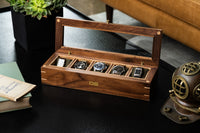The menswear staples with military roots are vast and sundry — the humble t-shirt, for example; the ‘jump’ boot; the pea coat. Many are unaware of these olive-drab origin stories, but one garment whose military bona fides are front and center has been getting more attention than the rest lately: namely, the so-called ‘commando sweater.’
 Craig as Bond wearing a military-inspired ribbed sweater from N. Peal - (Image by MGM)
Craig as Bond wearing a military-inspired ribbed sweater from N. Peal - (Image by MGM)
Blame it on Daniel Craig’s final turn as James Bond in 2021’s No Time to Die — or, more specifically, on the film’s brilliant costume designer, Suttirat Anne Larlarb — but it would seem that we can’t escape this tactical jumper. And for good reason: comfortable, robust, and available in a variety of colors, sizes, and finishes, the ‘commando sweater’ is a cool-looking, utilitarian garment that can be worn in a variety of settings, even if one didn’t pass through boot camp. (Though the boot camp part certainly adds a degree of authenticity.)
In analyzing this garment’s origins, we could conceivably look back as far as the Boer War, where its ancestors clothed British regiments back in the 19th century. However, the ‘commando sweater’ truly became recognizable as such during the dusty early days of the Second World War in the North African theater. It was here — the playground of early special operations units such as Ralph Bagnold’s L.R.D.G. (Long Range Desert Group) and David Sterling’s S.A.S. (Special Air Service) — that early commandos were first issued what later became known in British military circles as the ‘wooly pully.’
 Commando Sweater, Aegean Theater 1943 - 1944
Commando Sweater, Aegean Theater 1943 - 1944
Introduced to service in 1941, the ‘commando sweater’ went through several iterations. At first, it was simply a woolen jumper with a ‘boat’ neck closed by a shoelace-like drawstring, with no reinforcement at the elbows or shoulders. (L.R.D.G, S.A.S, and S.B.S. commandos operating the North African theater and later, in the Aegean and European theaters, can be seen wearing this simpler version.) In later iterations, the famed elbow pads, shoulder pads, and shoulder straps were added, while the boat neck was substituted for a v-neck or a crewneck.
For decades, ‘commando sweaters’ were produced from 100% wool with reinforcements in cotton and/or polyester; as a result, the garment was warm and had strong moisture-wicking properties, but could become itchy and required ironing or dry cleaning if it was to be worn over a uniform top in a more formal setting. As offshore manufacturing took hold, a transition to 100% acrylic was often seen, resulting in a garment that is inexpensive and warm, but is non-fire retardant and hydrophobic (meaning it repels water, which can lead to the growth of bacteria and to smells).
 Omega Seamaster 300 - IN THE SHOP
Omega Seamaster 300 - IN THE SHOP
Though originally issued to special units, the sweater soon became commonplace among all sorts of formations and amongst all ranks, from British commandos to I.D.F. paratroopers to mechanics and desk jockeys. While the sweater is far less standard issue-kit than in decades past — curiously, the Israel Defense Force, for example, currently issues them only to female soldiers — its excellent utilitarian remit lends itself equally well to the outdoorsman. While typically a ‘commando’ sweater is a ribbed woolen jumper with elbow patches, shoulder patches, shoulder straps, and a v-neck or crewneck, contemporary versions lacking one or multiple of these features, or featuring a zippered front, are often still referred to as such. (The shoulder straps in particular — which typically hold epaulettes with officer’s/NCO’s ranks or unit patches — are often done away with on civilian models.) If you’re in search of a vintage version, try plugging “wooly pully” into an eBay search, whereas military surplus stores are a great place to find a more modern version for not a lot of coin.
Available in original khaki and olive drab, navy blue, black, and many shades in between, modern commando sweaters are now produced by military outfitters such as Rothco; outdoor retailers such as L.L. Bean; and, most recently, by high-end menswear brands such a N. Peal, founded in London in 1936 — the latter being a superfine blend of wool and cashmere. (If your last name happens to be “Bond,” this is where the British government would shop for yours!)
No matter how you wear it, the commando sweater is a venerable sartorial legend.













